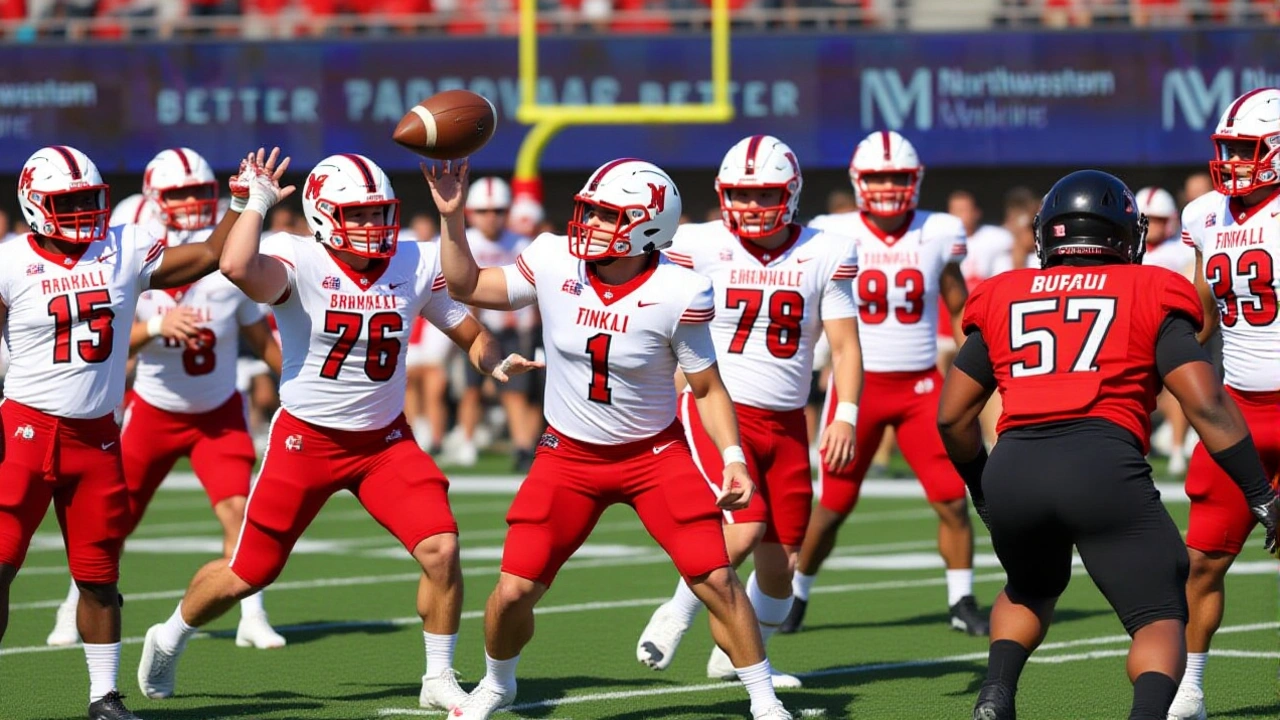When the final whistle blew at UB Stadium on Wednesday night, the Miami University RedHawks weren’t just celebrating a win—they were pulling off one of the most dramatic turnarounds in recent Mid-American Conference history. Down 20-17 with just over 10 minutes left, Miami scored 20 unanswered points to crush University at Buffalo Bulls’ postseason hopes in a 37-20 rout on November 19, 2025. The game, played before a chilly crowd in Buffalo, New York, wasn’t just about points. It was about momentum, resilience, and a freshman quarterback who announced himself on the biggest stage.
Buffalo’s Early Surge and Brief Lead
It started with a quiet bang. Buffalo’s kicker Jack Howes nailed a 38-yard field goal in the first quarter to give the Bulls a 3-0 lead. Miami’s offense looked sluggish, and Buffalo’s defense, led by linebacker K. Bradley, seemed to have answers for everything. Then came the second quarter—and everything flipped. Dom Dzioban drilled a 42-yard field goal, and the RedHawks’ offense, finally clicking, found the end zone twice. By halftime, Miami led 17-10 after Buffalo’s Ta’Quan Roberson connected with wideout Victor Snow on a 9-yard touchdown with 13 seconds left.
The third quarter began with Buffalo smelling blood. Roberson found Jasaiah Gathings for a 10-yard touchdown on the Bulls’ opening drive, tying the game at 17. A crucial fourth-down stop near midfield gave Buffalo fresh life. Moments later, Howes knocked through a 47-yard field goal, and suddenly, Buffalo was up 20-17—their first lead of the night. Fans erupted. The home team looked like the team that could make a bowl game.
The RedHawks’ Response: A Quarter for the Ages
But here’s the thing: Miami didn’t panic. They didn’t force it. They waited. And then they struck.
Enter Thomas Gotkowski, the freshman quarterback making his first start. With 11:47 left in the fourth, Gotkowski dropped back, found C. Weaver on a crossing route for 26 yards—despite a declined pass interference call on Buffalo’s K. Bradley. Three plays later, he plunged in from the 1-yard line. Touchdown. Miami led 24-20.
Then came D'Shawntae Jones. The running back, who had been quiet through three quarters, broke loose on a 48-yard scamper, finishing with a 14-yard touchdown run. The crowd fell silent. 31-20.
Buffalo’s next drive ended in a turnover on downs. Miami’s defense, which had looked gassed earlier, suddenly looked like a brick wall. On the ensuing possession, Gotkowski hit Jones again—this time on a 12-yard slant for his second touchdown of the night. 37-20. Game over.
Stats That Tell the Real Story
On paper, the numbers tell a tale of imbalance:
- Jordan Brunson rushed for 123 yards on 22 carries, the engine of Miami’s ground game.
- Gotkowski finished 18-of-25 for 197 yards and two touchdowns, with zero interceptions.
- Buffalo’s Ta’Quan Roberson threw for 241 yards and two scores but was sacked three times in the fourth quarter.
- Miami held Buffalo to just 3 yards on 10 rushing attempts in the final 15 minutes.
And the timing? Perfect. Miami’s 20 unanswered points came in just 9:13 of game time. Buffalo’s offense, which had been so sharp in the first three quarters, went 0-for-4 on fourth down in the final quarter.
What This Means for the MAC Standings
With the win, Miami improved to 6-5 overall and 5-2 in the Mid-American Conference, tying them with Ohio and Central Michigan for second place behind Western Michigan (6-1). For Buffalo, the loss dropped them to 5-6 (4-3 MAC)—a game behind the cutoff for bowl eligibility.
The MAC’s postseason bubble is tight. Only the top six teams qualify, and Buffalo now needs to beat Ohio University next Friday at 12:00 pm ET to have any chance. But with their offense sputtering and their defense gassed after a brutal fourth quarter, that’s a tall order.

Why This Game Matters Beyond the Box Score
This wasn’t just another MAC game. It was a microcosm of everything that makes college football unpredictable.
Gotkowski, a walk-on from Cincinnati, hadn’t thrown a single pass in a regular-season game before Wednesday. Now he’s the starter. Jones, a transfer from a junior college, became the hero. And Buffalo? They played with heart—but couldn’t close. The Bulls had every opportunity. They led. They controlled the clock. They had the momentum. But in the end, Miami’s poise under pressure made all the difference.
It’s also a reminder that in college football, one quarter can erase weeks of work. Buffalo’s coaching staff will have to answer tough questions. Did they overcommit? Did they underestimate Miami’s ability to adjust? And more importantly—can they fix it before Friday?
What’s Next?
Miami’s season isn’t over. They’ll face Toledo next week at home, with a chance to clinch a bowl berth. If they win, they’re in. If they lose? They’ll need help.
Buffalo, meanwhile, faces a do-or-die matchup with Ohio University on November 28. The winner likely gets a bowl invite. The loser? A 5-7 season and a long offseason of "what ifs."
The Mid-American Conference may not get the spotlight of the Power Five, but on nights like this, it proves it still delivers the drama.
Frequently Asked Questions
How did Thomas Gotkowski perform in his first start?
Thomas Gotkowski, a freshman making his first career start, completed 18 of 25 passes for 197 yards and two touchdowns with no interceptions. He also rushed for 11 yards on a key fourth-down conversion that set up Miami’s go-ahead score. His poise under pressure, especially in the fourth quarter, silenced doubts about his readiness and immediately made him the RedHawks’ starting QB.
Why did Buffalo’s offense collapse in the fourth quarter?
Buffalo’s offense, which had moved the ball efficiently in the first three quarters, was held to just 3 yards on 10 rushing attempts in the final 15 minutes. Miami’s defensive line began pressuring Ta’Quan Roberson relentlessly, forcing him into hurried throws and two critical fourth-down stops. The Bulls also lost their rhythm after their first three drives of the fourth quarter ended in punts and a turnover on downs.
What does this loss mean for Buffalo’s bowl eligibility?
Buffalo fell to 5-6 overall and 4-3 in MAC play, putting them one game behind the six-team bowl cutoff. They now must beat Ohio on November 28 to reach 6 wins. Even then, they’ll need help from other conference results—like Toledo losing to Miami or Akron losing to Kent State—to sneak in. Their chances are slim, but not impossible.
How did Miami’s defense turn things around?
After giving up 20 points in the first three quarters, Miami’s defense held Buffalo to zero points in the final 15 minutes. They tightened coverage on Jasaiah Gathings and Victor Snow, and the front seven generated consistent pressure on Roberson. Three sacks and two fourth-down stops in the fourth quarter were the difference—proving that discipline, not just talent, won the game.
Is this a sign of Miami’s resurgence under head coach Chuck Martin?
Absolutely. After a 1-4 start, Miami has won five of their last six games. The win over Buffalo marks their fifth conference victory, matching their total from last season. With a freshman QB stepping up and a defense finding its identity, the RedHawks are playing their best football of the year—and could be headed to their first bowl since 2020.
Where does this game rank in MAC history?
It’s among the most dramatic fourth-quarter comebacks in MAC history. Only three times since 2015 has a team overcome a 20-17 deficit in the final 10 minutes to win by 17+ points. This was the first time it happened in Buffalo. With both teams’ postseason hopes on the line, it’s already being called "The Night the RedHawks Rose" by local media.
